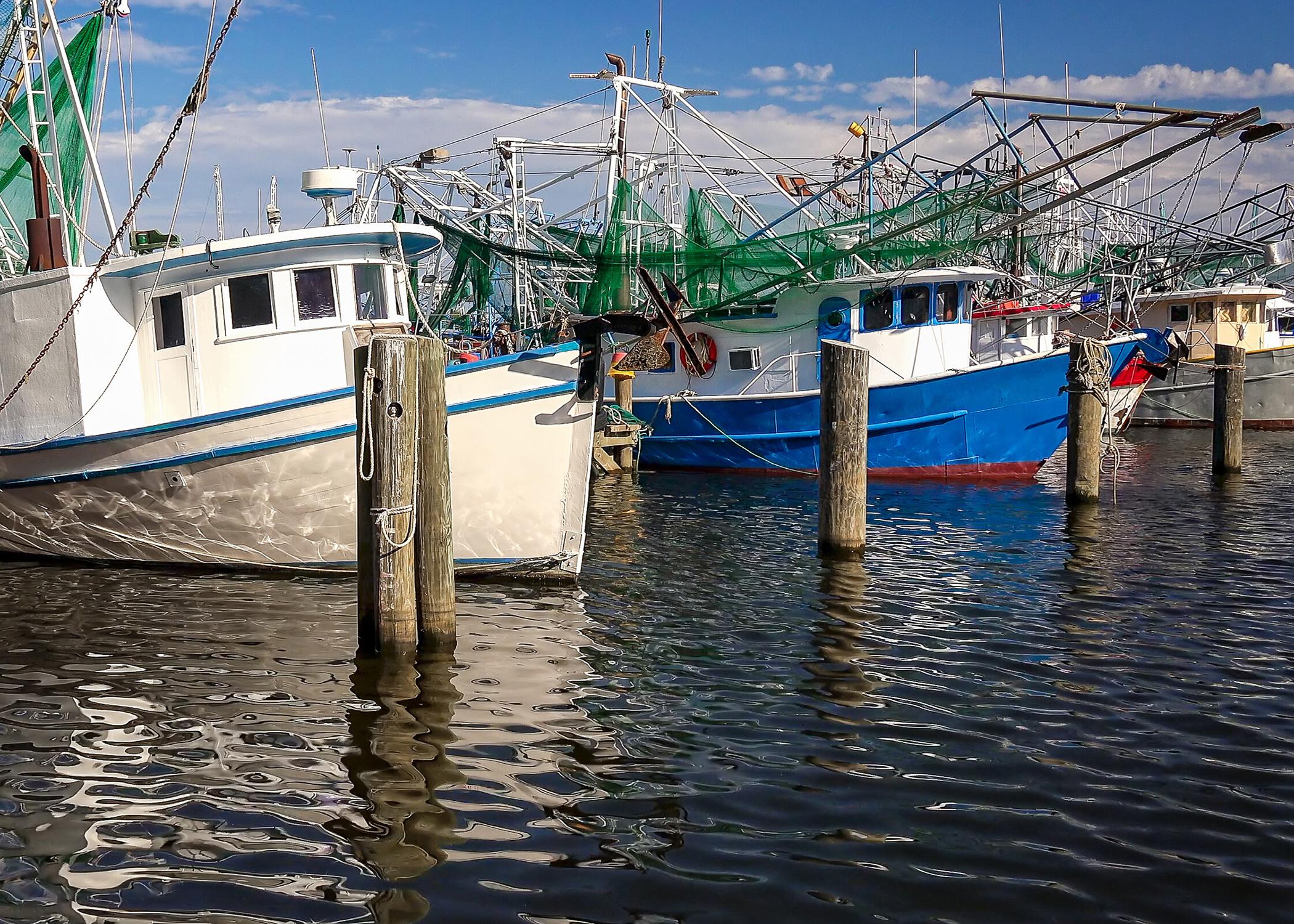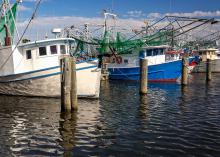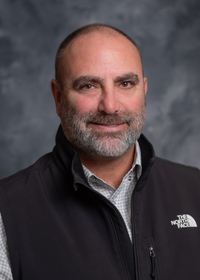Information Possibly Outdated
The information presented on this page was originally released on March 30, 2022. It may not be outdated, but please search our site for more current information. If you plan to quote or reference this information in a publication, please check with the Extension specialist or author before proceeding.
Fishing industry focuses on new fisheries, education
RAYMOND, Miss. -- For Mississippi’s commercial fishermen, stress is part of daily life, but the typical stressors they face have been intensifying for more than 10 years.
Environmental disasters, global markets, strict fishing regulations and the increasing average age of working fishers is bearing down on the industry, threatening its long-term viability.
All of these factors have Ryan Bradley concerned for the future of the Mississippi fishing industry. So, he is taking action to help fishers stay in the industry and draw young people to the business.
“This is a proud industry. We work hard. But it is a high-stress profession, and you have to be a thick-skinned person to do this job,” said Bradley, who is a fifth-generation commercial fisherman and the executive director of Mississippi Commercial Fisheries United, a nonprofit organization dedicated to protecting the common interests of the state’s fishermen, fishing industry and seafood consumers.
“There is a lot of uncertainty in this industry right now and not many coping mechanisms when it comes to dealing with the stress. We had over 2,000 shrimp boats 12 years ago; now, we have less than 200. It’s such a volatile business now, that commercial fishermen are encouraging their children not to go into the business,” Bradley said.
Bradley wants to see the industry thrive, and he is one of several people taking various steps to make that happen.
Along with other industry partners, he has helped organize an educational program for prospective young fishers. The program teaches high school students about the industry and pairs them with boat captains for hands-on internships, which can prepare them to work in the industry.
Marcus Drymon, Extension marine fisheries specialist at Mississippi State University, said fishermen training programs are an important part of bringing new people into the commercial industry. He and his colleagues at MSU and other institutions have put together a guide to training opportunities around the U.S.
Extension Publication 3527, “A Guide to Fishermen Training Programs,” is for commercial and recreational fishermen and is the first comprehensive guide to training opportunities for fishermen. It is available on the Extension website at http://extension.msstate.edu/publications/guide-fishermen-training-programs.
Drymon and team also have organized a commercial fishers training program that would provide in-person, hands-on training for individuals interested in commercial fishing.
“We have partnered with two other institutions to develop a program that would train new fishermen,” he said. “The program curriculum is in place, and we’ve made a funding request. We’re waiting to hear from that.”
Fishers began leaving the industry after Hurricane Katrina in 2005. That trend continued after the Deepwater Horizon Oil Spill in 2010. Multiple years of freshwater flooding from the opening of the Bonnet Carré Spillway, which began in 2011, wiped out the state’s wild oyster reefs and impacted shrimping.
Shrimp and oysters are historically two of Mississippi’s largest fisheries.
In fact, commercial fishing is significant to Mississippi’s economy, said Ben Posadas, a marine resources economist with the Extension Service and a researcher with the Mississippi Agricultural and Forestry Experiment Station.
In 2020, the most recent year for which numbers are available, total commercial landings brought in $52 million to the state. Despite the instability in shrimping in recent years, shrimp remained the state’s second most valuable commercial species, contributing $14.9 million between 2014 and 2020.
Oysters ranked fourth among Mississippi’s most valuable commercial fishing landings between 2014 and 2018, accounting for more than $821,000. In 2019, after too much freshwater influx from prolonged flooding, wild oysters could not survive in Mississippi’s waters.
Some fishers have now turned to oyster farming, or the practice of growing oysters from brood stock in off-bottom cages near Deer Island.
“This is new in Mississippi, but it is a very valuable program,” Bradley said. “We’ve had a lot of success with it, and the practice is growing,” Bradley said.
Other alternative crops include crabs and finfish, such as speckled trout and flounder. Those species have very small quotas, which makes it difficult to make a profit, Bradley said.
However, he and others are working to educate lawmakers about the importance of reform when it comes to quotas for commercial fishers, especially in inland waters where many of the fished species live.
“We are working hard to help our legislators on the state and federal level understand how the current laws affect fishers and their ability to make a living,” Bradley said. “Sen. Wicker has been able to get some legislation through on the federal level that has helped, and we’re grateful for that. But there is still a lot to do on this front.”
Fishers also face rising input costs and competition from global markets.
“For the past 12 years, fishing -- especially shrimping -- here in the U.S., here in the Gulf is very difficult,” Posadas told an MSU Television Center crew. “They have to spend so much money to fill up their tanks to go out fishing for four days, six days, and then, when they come back with their catch, the price is too low. Sometimes what they get out of the catch is not enough to pay for the diesel.”
Posadas said market prices present another impossible hurdle. U.S. fishers are competing with imported fish and seafood products, which are sold at lower prices. He compared prices of all the products sold in the U.S. with the same products imported from other countries and found that imports sell for between 50% and 75% less than the U.S. products.
“Who can compete with that? There is no way,” he said. “Margins are getting slimmer and slimmer -- sometimes one cent, two cents, maybe five cents for a dollar sale.
“That’s hard. A captain, a crew and maybe another crew, depending on the size of the boat, a 5 cent per dollar profit per sale is not enough to keep them in the boat,” Posadas said.
Consumers who want access to local seafood should carefully consider the products they purchase, Bradley said.
“Marine resources, whether in state or federal waters, belong to all Mississippians, not just the people who live on or near the coast,” he said. “Everyone in Mississippi deserves access to those resources. The pandemic has taught us that local food chains are vital.
“If you don’t live on the coast, your access is the access to the food supply those waters provide. You can vote with your dollars by buying Gulf seafood,” Bradley said.
Bradley said consumers should carefully read fish and seafood packaging. Look for wording that indicates the product is fished from U.S. waters.
“Be sure the package says caught in America, not packaged or made in America,” he said. “They can use wording that can mislead some consumers. If you are in a restaurant, always ask the server where they get their fish and seafood. If they won’t tell you, you probably shouldn’t be eating there.”
The Mississippi-Alabama Sea Grant and Extension created a video to explain the benefits of eating local, wild-caught seafood. View it at https://youtu.be/wTYYAhy4uak.
The MSU Television Center created a four-part video series that explores the issue of food insecurity in Mississippi. “The Hungriest State” is not yet available but soon can be found at https://films.msstate.edu. “The Fisherfolk” looked at the role of Mississippi’s fishing industry in the local food supply.








